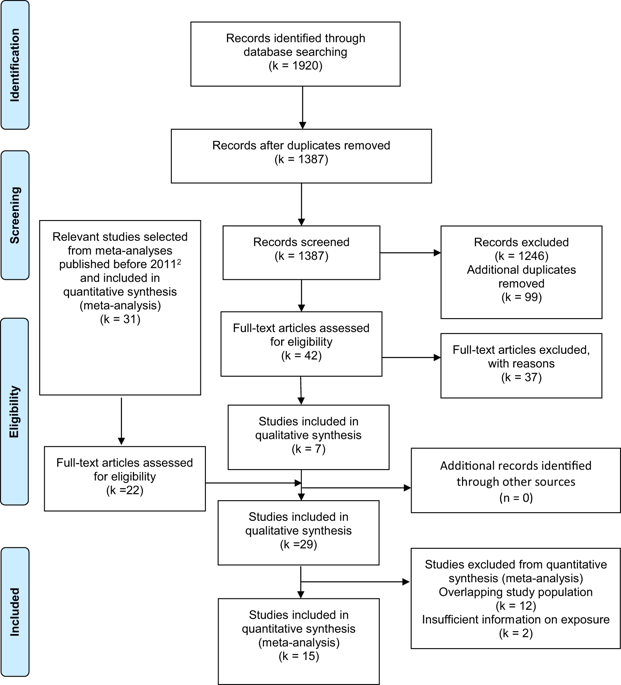当前位置:
X-MOL 学术
›
Eur. J. Clin. Nutr.
›
论文详情
Our official English website, www.x-mol.net, welcomes your
feedback! (Note: you will need to create a separate account there.)
Processed meat intake and incidence of colorectal cancer: a systematic review and meta-analysis of prospective observational studies.
European Journal of Clinical Nutrition ( IF 3.6 ) Pub Date : 2020-02-06 , DOI: 10.1038/s41430-020-0576-9 M N Händel 1 , J F Rohde 1 , R Jacobsen 1, 2 , S M Nielsen 1, 3 , R Christensen 1, 3 , D D Alexander 4 , P Frederiksen 1 , B L Heitmann 1, 5, 6, 7
European Journal of Clinical Nutrition ( IF 3.6 ) Pub Date : 2020-02-06 , DOI: 10.1038/s41430-020-0576-9 M N Händel 1 , J F Rohde 1 , R Jacobsen 1, 2 , S M Nielsen 1, 3 , R Christensen 1, 3 , D D Alexander 4 , P Frederiksen 1 , B L Heitmann 1, 5, 6, 7
Affiliation

|
The objective was to use accumulated evidence to explore the association between processed meat intake and risk of colorectal cancer (CRC) and to investigate the reliability of associations by evaluating patterns of risk by study population characteristics and research quality parameters. We included 29 observational prospective cohort studies with relative risk estimates and 95% confidence intervals for CRC according to various levels of processed meat consumption. Risk of bias was assessed using Risk Of Bias In Non-randomized Studies-of Interventions (ROBINS-I) tool. Data sources were PubMed and Embase up to January 2017. The summary relative risks for high versus low processed meat consumption and risk of CRC, colon, and rectal cancer were 1.13 (95% CI: 1.01, 1.26), 1.19 (95% CI: 1.09, 1.31), and 1.21 (95% CI: 0.98, 1.49), respectively. Similar estimates were observed for the dose-response analyses. Heterogeneity across studies was detected in most analytical models. The overall judgment showed that two out of 29 studies had a moderate risk of bias, 25 had a serious risk of bias, and 2 had a critical risk of bias. The bias domains most often rated critical were bias due to risk of confounding, bias due to missing data, and selective outcome reporting bias. Although this meta-analysis indicates a modest association between processed meat intake and an increased risk of CRC, our assessment of internal validity warrants a cautious interpretation of these results, as most of the included studies were judged to have serious or critical risks of bias.
中文翻译:

加工肉的摄入和大肠癌的发病率:前瞻性观察研究的系统评价和荟萃分析。
目的是使用积累的证据来探索加工肉的摄入量与大肠癌(CRC)风险之间的关联,并通过研究人群特征和研究质量参数评估风险模式来研究关联的可靠性。我们纳入了29项观察性前瞻性队列研究,根据不同的加工肉类消费量,对它们进行了相对风险估计和CRC置信区间为95%。使用非随机干预研究的偏倚风险(ROBINS-I)工具评估偏倚风险。数据来源为PubMed和Embase截至2017年1月。加工肉消耗量的高低相对总风险以及CRC,结肠癌和直肠癌的风险摘要是1.13(95%CI:1.01,1.26),1.19(95%CI: 1.09、1.31)和1.21(95%CI:0.98、1.49)。剂量反应分析观察到相似的估计。在大多数分析模型中都发现了研究的异质性。总体判断表明,在29项研究中,有2项具有中等偏见风险,25项具有严重偏见风险,2项具有重大偏见风险。最常被评定为严重的偏见域是由于混杂风险引起的偏见,由于缺少数据造成的偏见以及选择性结果报告偏见。尽管该荟萃分析表明加工肉类摄入量与CRC风险增加之间存在适度的关联,但我们对内部有效性的评估仍需对这些结果进行谨慎的解释,因为大多数纳入研究被认为存在严重或严重的偏倚风险。总体判断表明,在29项研究中,有2项具有中等偏见风险,25项具有严重偏见风险,2项具有重大偏见风险。最常被评定为严重的偏见域是由于混杂风险引起的偏见,由于缺少数据造成的偏见以及选择性的结果报告偏见。尽管该荟萃分析表明加工肉类摄入量与CRC风险增加之间存在适度的关联,但我们对内部有效性的评估仍需对这些结果进行谨慎的解释,因为大多数纳入研究被认为存在严重或严重的偏倚风险。总体判断表明,在29项研究中,有2项具有中等偏见风险,25项具有严重偏见风险,2项具有重大偏见风险。最常被评定为严重的偏见域是由于混杂风险引起的偏见,由于缺少数据造成的偏见以及选择性的结果报告偏见。尽管该荟萃分析表明加工肉类摄入量与CRC风险增加之间存在适度的关联,但我们对内部有效性的评估仍需对这些结果进行谨慎的解释,因为大多数纳入研究被认为存在严重或严重的偏倚风险。和选择性结果报告偏倚。尽管该荟萃分析表明加工肉类摄入量与CRC风险增加之间存在适度的关联,但我们对内部有效性的评估仍需对这些结果进行谨慎的解释,因为大多数纳入研究被认为存在严重或严重的偏倚风险。和选择性结果报告偏倚。尽管该荟萃分析表明加工肉类摄入量与CRC风险增加之间存在适度的关联,但我们对内部有效性的评估仍需对这些结果进行谨慎的解释,因为大多数纳入研究被认为存在严重或严重的偏倚风险。
更新日期:2020-02-07
中文翻译:

加工肉的摄入和大肠癌的发病率:前瞻性观察研究的系统评价和荟萃分析。
目的是使用积累的证据来探索加工肉的摄入量与大肠癌(CRC)风险之间的关联,并通过研究人群特征和研究质量参数评估风险模式来研究关联的可靠性。我们纳入了29项观察性前瞻性队列研究,根据不同的加工肉类消费量,对它们进行了相对风险估计和CRC置信区间为95%。使用非随机干预研究的偏倚风险(ROBINS-I)工具评估偏倚风险。数据来源为PubMed和Embase截至2017年1月。加工肉消耗量的高低相对总风险以及CRC,结肠癌和直肠癌的风险摘要是1.13(95%CI:1.01,1.26),1.19(95%CI: 1.09、1.31)和1.21(95%CI:0.98、1.49)。剂量反应分析观察到相似的估计。在大多数分析模型中都发现了研究的异质性。总体判断表明,在29项研究中,有2项具有中等偏见风险,25项具有严重偏见风险,2项具有重大偏见风险。最常被评定为严重的偏见域是由于混杂风险引起的偏见,由于缺少数据造成的偏见以及选择性结果报告偏见。尽管该荟萃分析表明加工肉类摄入量与CRC风险增加之间存在适度的关联,但我们对内部有效性的评估仍需对这些结果进行谨慎的解释,因为大多数纳入研究被认为存在严重或严重的偏倚风险。总体判断表明,在29项研究中,有2项具有中等偏见风险,25项具有严重偏见风险,2项具有重大偏见风险。最常被评定为严重的偏见域是由于混杂风险引起的偏见,由于缺少数据造成的偏见以及选择性的结果报告偏见。尽管该荟萃分析表明加工肉类摄入量与CRC风险增加之间存在适度的关联,但我们对内部有效性的评估仍需对这些结果进行谨慎的解释,因为大多数纳入研究被认为存在严重或严重的偏倚风险。总体判断表明,在29项研究中,有2项具有中等偏见风险,25项具有严重偏见风险,2项具有重大偏见风险。最常被评定为严重的偏见域是由于混杂风险引起的偏见,由于缺少数据造成的偏见以及选择性的结果报告偏见。尽管该荟萃分析表明加工肉类摄入量与CRC风险增加之间存在适度的关联,但我们对内部有效性的评估仍需对这些结果进行谨慎的解释,因为大多数纳入研究被认为存在严重或严重的偏倚风险。和选择性结果报告偏倚。尽管该荟萃分析表明加工肉类摄入量与CRC风险增加之间存在适度的关联,但我们对内部有效性的评估仍需对这些结果进行谨慎的解释,因为大多数纳入研究被认为存在严重或严重的偏倚风险。和选择性结果报告偏倚。尽管该荟萃分析表明加工肉类摄入量与CRC风险增加之间存在适度的关联,但我们对内部有效性的评估仍需对这些结果进行谨慎的解释,因为大多数纳入研究被认为存在严重或严重的偏倚风险。











































 京公网安备 11010802027423号
京公网安备 11010802027423号